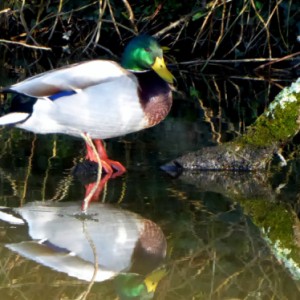Blue and yellow
A warm sunny day with a more than a hint of spring, perfect for an afternoon walk. The birch twigs were flushed with red and as I aimed my camera at them I noticed the blue tit.
Linnaeus, perfectly sensibly, named this bird Parus caeruleus meaning tit, dark blue, in classical Latin. Recently taxonomists in their wisdom have decided it belongs to the genus Cyanistes which in ancient Greek also means... dark blue.
Later we passed a pond when I often see a pair of wild ducks. Sure enough a handsome mallard drake (extra) was preening himself with coral-coloured feet gripping a semi-submerged log, glossy green head gleaming and a beak of banana yellow. His partner may have been there too but likely slaving over a clutch of eggs in a well-concealed nest.
Male ducks are notorious Lotharios, to put it mildly, and it seems they advertise their desirability via the colour of their beaks. A 2011 study revealed that some mallard drakes have more successful sperm than others (because it possesses anti-bacterial qualities) and these males have brighter yellow beaks - to which female ducks are attracted.
A bit like flourishing your coronavirus vaccination certificate I suppose, it's a guarantee of some protection.
Update; it's a Great Tit!!
(which make me an even greater tit, mis-identifying a bird blip two days running.)


Comments
Sign in or get an account to comment.


